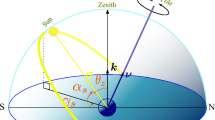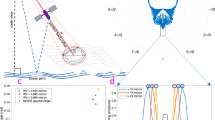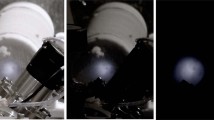Abstract
THE vertical beam through a low sun is generally referred to the reflection of sunlight from the basal surfaces of thin plates of ice which are falling through the atmosphere with their crystal axes vertical and horizontal. It has been the writer's good fortune to examine such reflections from individual “plates” that were slowly falling within a metre or so of the observer. Most of the plates were asymmetric portions of flat crystal growths, and they, spun rapidly as they fell, with a motion resembling that of a falling maple-key. In this case, the vertical beam was observed to spread out slightly as it receded from the sun, and the angle subtended by the edges of the beam was obviously the complement of the vertical angle of the “cone” swept out by the rapidly rotating, but slowly falling flake.
This is a preview of subscription content, access via your institution
Access options
Subscribe to this journal
Receive 51 print issues and online access
$199.00 per year
only $3.90 per issue
Buy this article
- Purchase on Springer Link
- Instant access to full article PDF
Prices may be subject to local taxes which are calculated during checkout
Similar content being viewed by others
Author information
Authors and Affiliations
Rights and permissions
About this article
Cite this article
BAKER, W. “Artificial” Vertical Beam. Nature 111, 185–186 (1923). https://doi.org/10.1038/111185c0
Issue Date:
DOI: https://doi.org/10.1038/111185c0
Comments
By submitting a comment you agree to abide by our Terms and Community Guidelines. If you find something abusive or that does not comply with our terms or guidelines please flag it as inappropriate.



